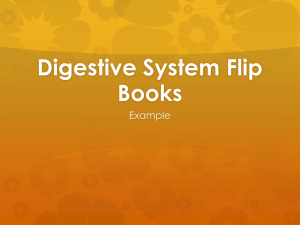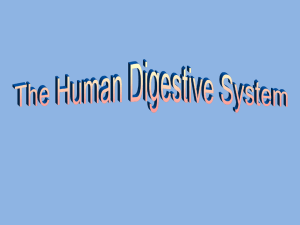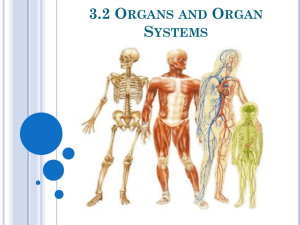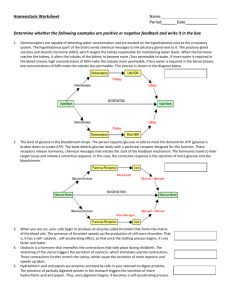Human Body Part 1 Study Guide 7S
advertisement
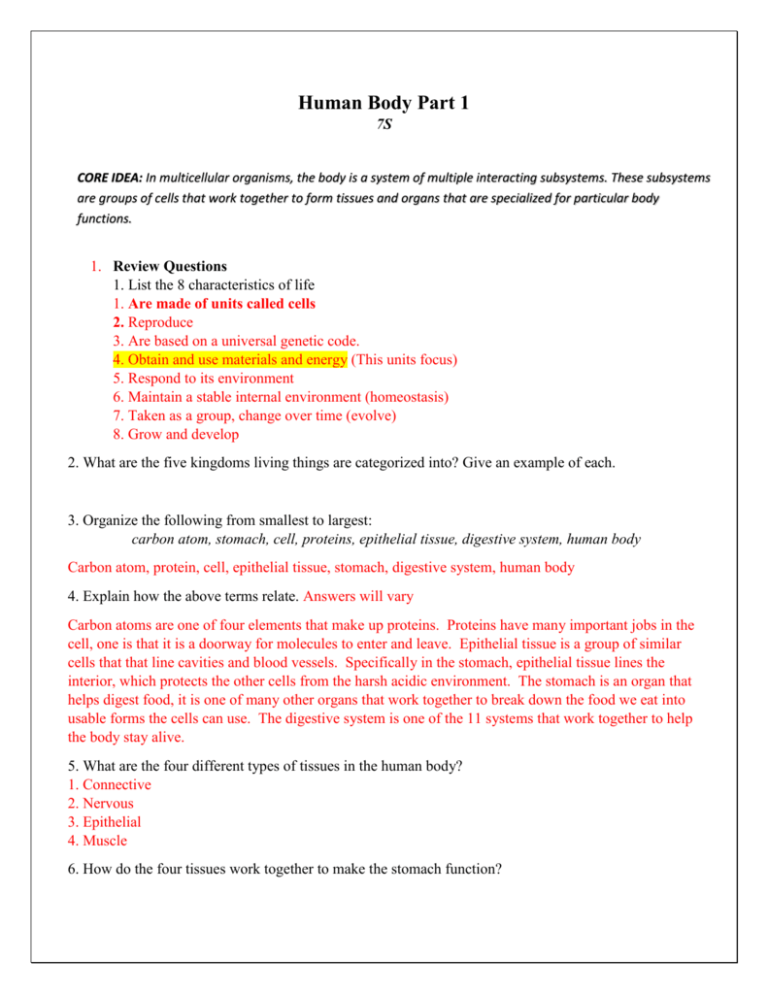
Human Body Part 1 7S CORE IDEA: In multicellular organisms, the body is a system of multiple interacting subsystems. These subsystems are groups of cells that work together to form tissues and organs that are specialized for particular body functions. 1. Review Questions 1. List the 8 characteristics of life 1. Are made of units called cells 2. Reproduce 3. Are based on a universal genetic code. 4. Obtain and use materials and energy (This units focus) 5. Respond to its environment 6. Maintain a stable internal environment (homeostasis) 7. Taken as a group, change over time (evolve) 8. Grow and develop 2. What are the five kingdoms living things are categorized into? Give an example of each. 3. Organize the following from smallest to largest: carbon atom, stomach, cell, proteins, epithelial tissue, digestive system, human body Carbon atom, protein, cell, epithelial tissue, stomach, digestive system, human body 4. Explain how the above terms relate. Answers will vary Carbon atoms are one of four elements that make up proteins. Proteins have many important jobs in the cell, one is that it is a doorway for molecules to enter and leave. Epithelial tissue is a group of similar cells that that line cavities and blood vessels. Specifically in the stomach, epithelial tissue lines the interior, which protects the other cells from the harsh acidic environment. The stomach is an organ that helps digest food, it is one of many other organs that work together to break down the food we eat into usable forms the cells can use. The digestive system is one of the 11 systems that work together to help the body stay alive. 5. What are the four different types of tissues in the human body? 1. Connective 2. Nervous 3. Epithelial 4. Muscle 6. How do the four tissues work together to make the stomach function? 1. Connective called collagen are found in the walls of the stomach 2. Nervous tissue in the stomach partly controls the production of acids that aid in the digestion of food. It signals when the stomach is full. 3. Muscle tissue: Aid in mechanical digestion. 4. Epithelial tissue lines the stomach. It produces mucus to protect the cells against the harsh acidic environment. 7. List the 11 body systems in the human body 1. Integumentary 7. Reproductive 2. Muscular 8. Lymphatic/Immune 3. Skeletal 9. Digestive 4. Cardiovascular/Circulatory 10. Endocrine 5. Respiratory 11. Nervous 6. Urinary Digestive System Organs and Structures – Relevant Vocabulary know location and function oral cavity tongue pharynx (throat) esophagus stomach small intestine (villus) large intestine (colon) rectum anus appendix salivary glands liver gall bladder pancreas sphincter epiglottis mechanical and chemical digestion nutrients absorption elimination gastric juice enzymes hydrochloric acid (HCl) calories (energy) macromolecules (protein, fats, and carbohydrates (sugars and starches)) fiber peristalsis bolus chyme parietal cell - HCL chief cell –make pepsin bile bile duct villus capillaries Enzymes: pepsin trypsin amylase lipase Review Questions 1. What is the function of the digestive system? To break down large food particles into smaller ones to be able to be absorbed into the blood stream and travel to cells. 2. Why do we have to eat? 1. Nutrients (matter) 2. Energy (bonds between the atoms of the food we eat) - We need both to grow and develop and repair and replace damaged tissue. 3. What is the difference between the GI track and accessory organs? What structures belong to each? GI Track - Oral Cavity, Esophagus, Stomach, Small Intestine, and Large intestine. Accessory Organs - Salivary Glands, Pancreas, Liver, and Gall Bladder 5. What is the importance of mechanical digestion and where does it take place? It breaks large food particles into smaller pieces, to expose a lot of surface area so enzymes can chemically beak down the molecules into smaller ones that can be used by the cell. This takes place in the mouth and stomach. 6. Distinguish between mechanical and chemical digestion? Mechanical digestions: Is the physical breakdown of large pieces into small pieces. Chemical digestion: Is when enzymes act on the polymer (carbohydrate) and chemically break it down into monomers (sugars). A chemical reaction occurs. 7. Fill out the chart Macromolecule Location of chemical breakdown Enzyme that breakdown molecule Carbohydrates Mouth and SI (duodenum) Amylase Protein Stomach and SI (duodenum) Lipids SI (duodenum) Pepsin in the stomach and Trypsin in the SI. Lipase 9. What are three things your tongue does for you? 1. Taste Food 2. Move food around for chemical digestion. swallowing 3. Helps in 10. How are the liver, bile, bile salts, lipids, and lipase related? 1. Liver produces bile 2. Bile salts that are made in the liver attach to the lipids so it can be chemically broken down by lipase. 11. How do the chief and parietal cells work together to break down proteins into amino acids? 1. Chief cells secrete pepsin, pepsin breaks down proteins in the stomach. Only when the pH is 2. 2. Parietal cells secrete HCL to maintain the pH of gastric juices. 3. IF the pH changes, pepsin doesn’t work, therefore proteins will not be broken. 12. What are the similarities and differences between the small and large intestine? Small Intestine Similarities Large Intestine Absorption of nutrients 21 ft long enzymes Both break down food broken down into sections Absorption of water 6ft long E.coli 13. How is the small intestine structured to increase surface area? 14. How does food travels through the digestive track. Watch video in digestive system video Respiratory System and Cellular Respiration Organs and Structures – know location and function nasal cavity pharynx –throat larynx- voice box trachea – windpipe epiglottis bronchi bronchioles alveoli alveolar sac lungs diaphragm Relevant Vocabulary nostrils cilia vocal cords breathing inspiration/expiration (inhalation/exhalation) respiration oxygen O2 carbon dioxide CO2 oxidation anaerobic aerobic lactic acid fermentation alcohol fermentation glucose Review Questions: 1. What are the two jobs of the respiratory system? 1. Get oxygen into the blood stream, and remove carbon dioxide from the body (gas exchange). 2. Filter, moisten, and warm air. 2. What are the three jobs done by the blood vessels, cilia, and mucus in your nasal cavity? Blood Vessels: Warm Air Cilia: Filter Air Mucus: Moistens air and traps particulates. 3. Why is it better to breathe through your nose instead of your mouth? It filters, moistens, and warms the air. 4. Why does your trachea need to have cartilage rings? To keep it open so oxygen and carbon dioxide get into and out of the body without being blocked. 5. How does the oxygen you bring into your body get into the circulatory system? (use diffusion in your response) When air rushes into the lungs it diffuses across the alveolar sacs into the blood stream. 6. What position must the diaphragm be in when you inhale? Exhale? Inhale: Contracted Exhale: Relaxed 7. How do the terms breathing, circulation, and respiration relate? We breathe in oxygen, it enters our blood, it circulates to our cells, and it then diffuses into our cells, and is available for respiration to occur. 8. Explain how oxygen gets from the air we breathe to our cells. We breathe in oxygen, it enters our blood, it circulates to our cells, and it then diffuses into our cells, and is available for respiration to occur. 9. What is the difference between anaerobic and aerobic respiration? Give an example of an organism that does each. Anaerobic: Do not need oxygen present to get energy from food ie. Yeast and some bacteria Aerobic: Need oxygen present to release energy from food ex humans and plants 10. Fill out the chart below about cellular respiration Who Most living things What The process of oxidizing food molecules and releasing carbon dioxide and water Where Cytoplasm of prokaryotic and mitochondria of eukaryotic cells. Why To release energy from food molecules to use for energy consuming activities in the cell. ALL the time!!!! When C6H12O6 + 6 O2 + → 6 H2O + 6 CO2 Reactants Products (energy is released, it is NOT considered a product) 11. Write out the balanced chemical equation for cellular respiration? 12. Label the reactants and products. 13. How many atoms are in the reactants? ___36_____Products? ____36____Show your work 14. Where is the energy stored? In the chemical bonds between the atoms. 15. Explain what happens in a chemical reaction. (edited question) Matter cannot be created or destroyed only rearranged. Energy is transferred. 16. Describe how the respiratory and digestive system work together to help humans survive. The digestive system breaks down the food we eat into small molecules that can be used by the cells. The respiratory system brings in the oxygen we need to be able to get the energy out of our food to be able to do life sustaining functions.






